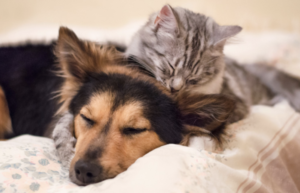Cat fleas—one of the greatest enemies for any cat partner!
Especially if you have an outdoor cat that likes to play with stray or feral cats, you often find fleas roaming around in their fur. It’s natural that at the first clue, you’d panic and grab that emergency shampoo, but wait!

Have you wondered why your cat keeps getting a recurring case of fleas? Let’s go into detail on cat fleas and what the right treatments and preventative steps are so you can be free of cat fleas once and for all.
Causes of Cat Fleas
While your cat may get the odd flea or two from other cats, there are several other causes for your cat getting a case of the fleas:
- It may have come in close contact with another animal, such as a squirrel or a dog.
- It may have come in contact with a person who came in contact with fleas.
- It may be out exploring and have gotten fleas from its surroundings. These are called “hitchhiker fleas.”
However, if your cat gets fleas, know that it’s pretty easy for them to catch fleas. If you don’t want them to catch fleas, you must monitor your cat’s movements. If you have an outdoor cat, train it to stay in the backyard or garden.
And maintain your home, so no stray animal makes its way into your home. If you have an indoor cat, it may never get fleas since you’ll likely keep your home clean anyway. But, there is a chance that another animal may bring in fleas and give your cat an infestation.
Signs of Cat Fleas
There are several simple indicators of cat fleas, such as:
- Biting, licking, and scratching: Of course, cats do scratch, bite, and lick themselves as part of their grooming process. That doesn’t mean they have a flea problem. But, if your cat starts scratching in one area specifically, so much so that they draw blood, it’s most likely itchiness caused by fleas.
- Skin Problems and Hair Loss: As indicated by their excessive grooming, if your cat starts getting bald spots and breaks the skin, that’s an indication of a flea infestation. It occurs when fleas feed on blood. When they do so, they transfer saliva, which their body is reactive to. The allergic response causes excessive itchiness and rashes.
- Behavioral Changes: Like a child who has lice, you can expect your cat to behave the same way as they. They may become irritable, uncomfortable, agitated. Your cat may also become restless, may hiss if you pick them up, and may want to be left alone.
- Pale gums: This is an indication of a severe flea infestation. It’s more common in smaller cats and kittens. However, if an older cat gets severely infected, it can also show signs of flea anemia, which in some cases can become fatal.
- Black specks on the cat’s bedding or in their coat: This is the most common indicator. If your cat’s bed is speckled with black spots and flecks, that is flea feces and dried, undigested blood. You’ll also find fleas and black specks in the cat’s coat, near the roots. You’ll also have trouble getting the specks out, whether with your nails or a nit comb.
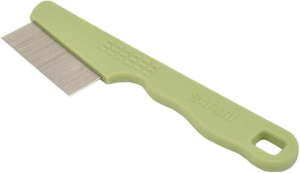
Treating Cat Fleas
If your cat has fleas, you must take action quickly!
It doesn’t take long for a few fleas to multiply and cause a full-blown infestation. A female adult flea can lay around 50 eggs a day. And as long as these eggs hatch and continue to feed on the cat’s blood, your cat will suffer.
To find out exactly how bad the situation is, take a wet paper towel and wipe it on your cat’s side. If it comes off with many specks and flecks, you know the case is a bad one.
Typically, when it comes to treating cat flea infections, we recommend taking the cat to the veterinarian, who will treat your cat with a minimum amount of flea treatment.
Yes, there are many over-the-counter flea treatments available. However, applying too much of the product or too frequently can cause an overdose, which can damage your cat’s health. Keep in mind, some of these treatments are poisonous, and cats like to lick themselves. We don’t want a necessary flea treatment to take a wrong turn.
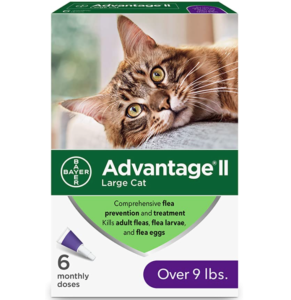
View on Amazon
Instead, allow the vet to treat your cat and ask them for any at-home precautions or treatment options. If you have multiple pets, bring them along in separate carriers and have them seen as well. They may also have picked up fleas.
After your cat receives treatment, keep an eye on its condition to get a regular dose. Your cat will want to scratch, bite, and lick themselves, but only allow them to do so once you’ve wiped them of the product. Otherwise, ask your veterinarian about using an Elizabethan cone.
If, after a few days, your cat continues to scratch and bite as it did before, take them to the vet again for secondary treatment.
Further Treatments for Cat Fleas
There are a wide variety of products available that can help prevent cat fleas, for example:
· Sprays
Flea sprays are typically useful for spot-on treatments. But the noise of a spray can be upsetting for some cats. Nevertheless, a spray is a good option if you want to take care of one or two fleas.

View on Amazon
· Collars
While flea collar are popular, they only prevent fleas from gathering around the neck (a common area for fleas). These collars also cause irritation and hair loss and generally irritate cats who aren’t used to wearing collars, so you may need to rethink that choice.

View on Amazon
· Medication
You’ll find many cat flea medication options. These tablets or liquids are given to the cat orally, which, when absorbed by the body, sterilizes the fleas or kills them when they bite to feed on the blood. You can also use injections. However, you will need to use a topical treatment alongside.
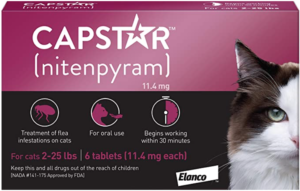
View on Amazon
· Shampoos
You can use flea shampoos to bathe your cat which kills the unwanted visitors. They are convenient and easy to use and most are gentle enough for your pet while killing fleas and other insects like ticks. When choosing a shampoo keep in mind that cats can be sensitive to certain chemicals, oils and fragrances. A popular ingredient, pyrethrin, can lead to toxic overload in some cats which exceeding recommended quantities.
Natural pyrethrins such as rosemary and chrysanthemums are considered much safer for your cat, especially younger cats. Synthesized pyrethrins break down much slower and can be highly toxic, however they are safe to use provided you follow the instructions; you should also make sure your cat is not allergic. Synthesized pyrethrins are more effective at killing flea eggs and larvae and providing long-lasting protection.
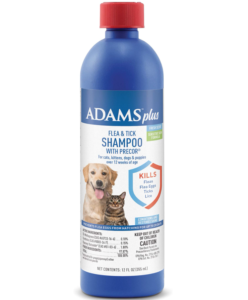
View on Amazon
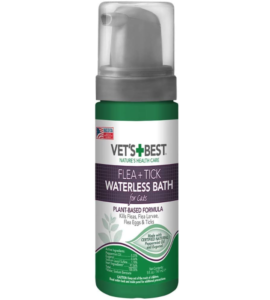
View on Amazon
· Powders
Powders are old-fashioned and messy, but they get the job done. The only caveat is that the powder stays on your cat’s coat. Unfortunately, given a cat’s nature, that’s not possible. Not to mention that powders cause illness when inhaled or swallowed, so not the most viable option.
While these options are useful, many vets typically use various sprays and powders that can be quickly washed off or cleaned off to treat cats with different thickness coats.
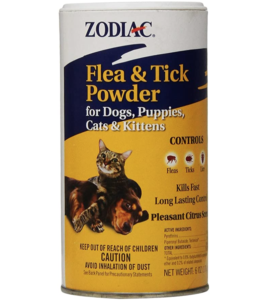
View on Amazon
Preventing Cat Flea Infestation in Future
The best way to prevent your cat from getting cat fleas in the future is to treat your home, soft furnishings, and carpets alongside. Wash them on high heat, wash your cat’s bedding, and try to keep them inside as much as possible.
Also, ask the vet for a flea check every time you go for a regular checkup. And maintain your cat’s cleanliness however possible. With the right methods and baths, your cat will likely stay flea-free for the rest of its life!









